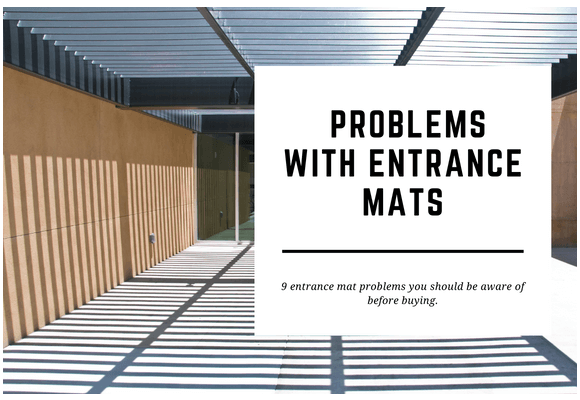
9 Problems with Entrance Mats
Entrance mat problems you should be aware of before buying.
We have covered the best entrance mats in detail, but many of our customers want to know the disadvantages of floor mats too. Every product in existence likely has some downfalls and being aware of those will help you make the right decision the first time.
At Matshop, we strive to bring you unbiased and holistic recommendations for all your matting needs. So, here are some of the problems with entrance mats:
-
PVC-backed mats slide around on floors
PVC-backed entrance matting does not provide adequate protection against slips, trips and falls. As PVC is smooth, these mats slide underfoot. Loose-laid matting should have rubber backing or be fixed to the floor using non-marking tape.
Alternatively, go for a recessed entrance mat. Find out more about whether a recessed or loose-laid mat is best for your application.
-
PVC-edged mats curl over time
Another issue with using PVC to make matting is that it curls over time. If PVC (vinyl) is used for the edging only, this curling misshapes the mat and creates an unsightly trip hazard. Instead, use a lay flat backing option such as synthetic rubber.
You should also store mats according to the manufacturer’s recommendation. Get in touch for your free poster showing how to store your mats.
-
Natural rubber mats leave marks on the floor
Something anyone that wore black shoes to school knows well is that rubber leaves markings on hard surfaces. This is a disadvantage of using loose-laid rubber matting or carpet-surfaced matting with a rubber backing.
To avoid marking your floor, only lay it on a completely dry surface. If the floor has been sealed, make sure that it has completely cured before installing your mat. You can ask your sealer manufacturer or installer for their recommended instructions and time.
If you are using a mat on timber we recommend a synthetic rubber backing.
-
Entrance mats scratch floors
If you place your mat on a dirty floor, the dirt reduces the amount of friction it has with the floor. Over time, this will cause the mat to slide around and scratch the floor. That may leave you with noticeable scratches when you remove the mat.
To avoid this, place your mats on a thoroughly cleaned and dried floor.
-
Entrance matting discolours your floor
Some entrance mats cause floors to discolour, and this is particularly true for PVC (vinyl).
This is caused by a process called colour migration, which is particularly common in sealed floors. Once again, you can avoid this by making sure that the sealer has completely cured before installing your mat.
Also, check that the sealer you plan to use will not have a chemical reaction with the backing material of the mat.
-
Entrance mats are a slip hazard
If you use cheap, lightweight entrance matting, it will become a slip hazard. Without enough weight to keep itself down, a lightweight mat will slide around, flick up at the edges and possibly even blow away in the wind.
To avoid this, fix your entrance mat to the floor, install it in a mat recess or use something with a heavy rubber backing.
-
Entrance Mats bubble up and create a trip hazard
If your mat is installed in a recess that does not meet the Australian building code, it will bubble and ripple. As the recess cures, it releases moisture and gas. This pushes up the material and creates dangerous bubbles.
Use recommended floor leveller when creating a mat well recess. If your matting installer uses sand and cement, be prepared for a life of headaches and hazards! It is cheaper to install but will not last the life of the mat and will certainly create a hazard.
-
Entrance Mats rattle when walked over
Although aluminium mats have rubber buffers or PVC buffers on their undersides, they do start to make an annoying clattering noise over time. This is unpleasant for customers and clients entering your luxurious building.
Find out more about the problems with aluminium matting before choosing to use this style of entrance mat.
-
Entrance mats are hard to clean
Although this sounds like more work for your cleaners, it is a huge cost and time saver. If your mat is collecting debris, dirt and mud then it is doing its job.
Be wary of an entrance mat that is easy to clean, as it’s probably not collecting the dirt. Instead, that dust is probably being walked straight into your building.
Still want an entrance mat?
As always, we want to equip you with all the knowledge you need to make an informed decision. Entrance mat problems exist, so hopefully you are now in a position to decide whether one is right for you.
If you still know an entrance mat is perfect for you, great! We are happy to help. You can reach our team of friendly matxperts at [email protected] or by calling 1300 628 746.
During business hours, you can also get in touch using the chat function below. For more guidance on choosing your entrance mat, check out the Buying Guide for Commercial Entrance Mats.

